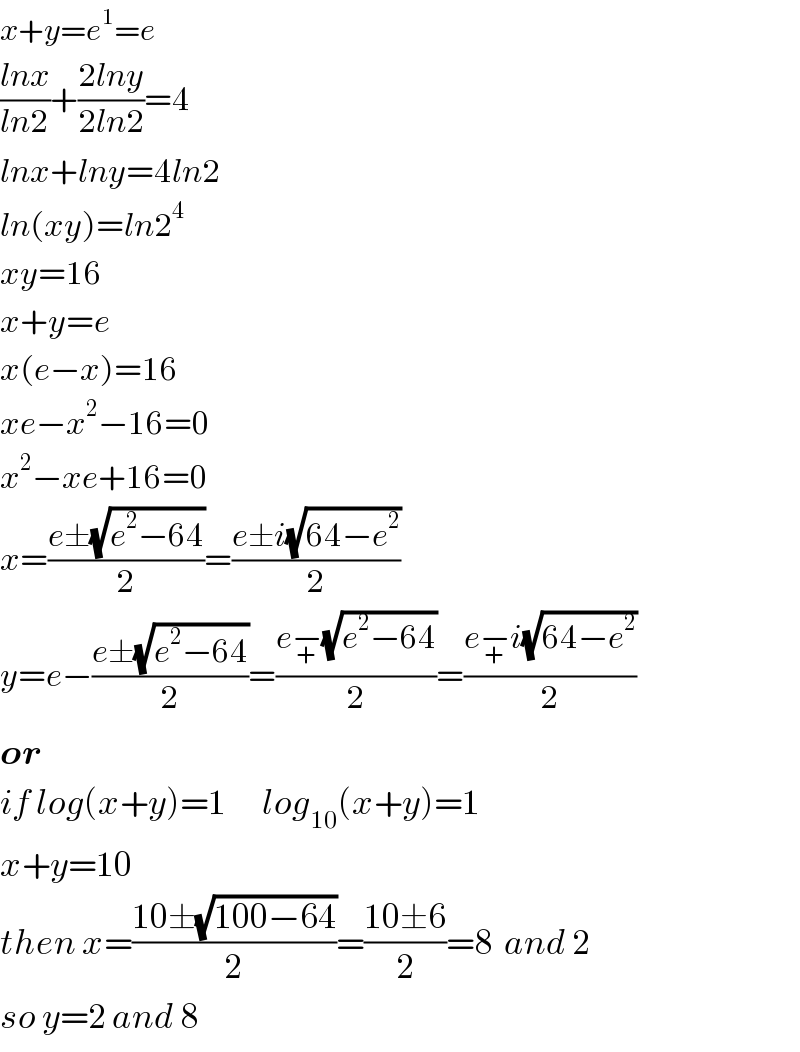
Question Number 42289 by mondodotto@gmail.com last updated on 22/Aug/18

$$\boldsymbol{\mathrm{log}}\left(\boldsymbol{{x}}+\boldsymbol{{y}}\right)=\mathrm{1} \\ $$$$\boldsymbol{\mathrm{log}}_{\mathrm{2}} \boldsymbol{{x}}+\boldsymbol{\mathrm{log}}_{\mathrm{4}} \boldsymbol{{y}}^{\mathrm{2}} =\mathrm{4} \\ $$
Commented by math khazana by abdo last updated on 22/Aug/18

$$\Rightarrow{x}+{y}\:={e}\:{and}\:\:\frac{{ln}\left({x}\right)}{{ln}\left(\mathrm{2}\right)}\:+\frac{{ln}\left({y}^{\mathrm{2}} \right)}{{ln}\left(\mathrm{4}\right)}\:=\mathrm{4}\:\Rightarrow \\ $$$${x}+{y}\:={e}\:{and}\:{ln}\left({x}\right)\:+{ln}\left({y}\right)\:=\mathrm{4}{ln}\left(\mathrm{2}\right)\:={ln}\left(\mathrm{2}^{\mathrm{4}} \right)\:\Rightarrow \\ $$$${x}+{y}\:={e}\:{and}\:{ln}\left({xy}\right)\:={ln}\left(\mathrm{16}\right)\:\Rightarrow \\ $$$${x}+{y}\:={e}\:{and}\:{xy}\:=\mathrm{16}\:\Rightarrow\:{xand}\:{y}\:{are}\:{solution}\:{of}\:{the} \\ $$$${equation}\:{u}^{\mathrm{2}} \:−{eu}\:+\mathrm{16}\:=\mathrm{0} \\ $$$$\Delta\:={e}^{\mathrm{2}} −\mathrm{4}\left(\mathrm{16}\right)\:={e}^{\mathrm{2}} −\mathrm{64} \\ $$$${if}\:{x}\:{and}\:{y}\:{are}\:{real}\:\Rightarrow{no}\:{solution}\:{if}\:{x}\:{and}\:{y}\:{are} \\ $$$${complex}\:\Rightarrow\:{u}_{\mathrm{1}} =\frac{{e}+{i}\sqrt{\mathrm{64}−{e}^{\mathrm{2}} }}{\mathrm{2}} \\ $$$${u}_{\mathrm{2}} =\frac{{e}\:−{i}\sqrt{\mathrm{64}−{e}^{\mathrm{2}} }}{\mathrm{2}}\:\:. \\ $$
Answered by tanmay.chaudhury50@gmail.com last updated on 22/Aug/18

$${x}+{y}={e}^{\mathrm{1}} ={e} \\ $$$$\frac{{lnx}}{{ln}\mathrm{2}}+\frac{\mathrm{2}{lny}}{\mathrm{2}{ln}\mathrm{2}}=\mathrm{4} \\ $$$${lnx}+{lny}=\mathrm{4}{ln}\mathrm{2} \\ $$$${ln}\left({xy}\right)={ln}\mathrm{2}^{\mathrm{4}} \\ $$$${xy}=\mathrm{16} \\ $$$${x}+{y}={e} \\ $$$${x}\left({e}−{x}\right)=\mathrm{16} \\ $$$${xe}−{x}^{\mathrm{2}} −\mathrm{16}=\mathrm{0} \\ $$$${x}^{\mathrm{2}} −{xe}+\mathrm{16}=\mathrm{0} \\ $$$${x}=\frac{{e}\pm\sqrt{{e}^{\mathrm{2}} −\mathrm{64}}}{\mathrm{2}}=\frac{{e}\pm{i}\sqrt{\mathrm{64}−{e}^{\mathrm{2}} }}{\mathrm{2}} \\ $$$${y}={e}−\frac{{e}\pm\sqrt{{e}^{\mathrm{2}} −\mathrm{64}}}{\mathrm{2}}=\frac{{e}\underset{+} {−}\sqrt{{e}^{\mathrm{2}} −\mathrm{64}}}{\mathrm{2}}=\frac{{e}\underset{+} {−}{i}\sqrt{\mathrm{64}−{e}^{\mathrm{2}} }}{\mathrm{2}} \\ $$$$\boldsymbol{{or}} \\ $$$${if}\:{log}\left({x}+{y}\right)=\mathrm{1}\:\:\:\:\:\:{log}_{\mathrm{10}} \left({x}+{y}\right)=\mathrm{1} \\ $$$${x}+{y}=\mathrm{10} \\ $$$${then}\:{x}=\frac{\mathrm{10}\pm\sqrt{\mathrm{100}−\mathrm{64}}}{\mathrm{2}}=\frac{\mathrm{10}\pm\mathrm{6}}{\mathrm{2}}=\mathrm{8}\:\:{and}\:\mathrm{2} \\ $$$${so}\:{y}=\mathrm{2}\:{and}\:\mathrm{8} \\ $$
